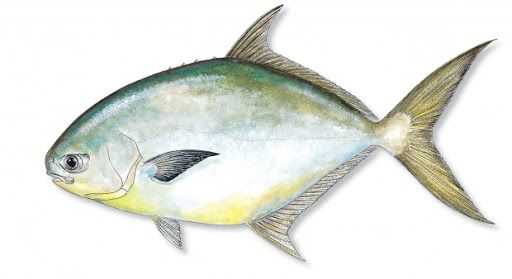Great Pompano

Species Details
Trachinotus Goodei
Carangidae
Perciformes
Sandy shores, Coastal Lines, Coral Reefs
1 - 560 lbs.
11" - 20"
Great Pompano Description
The Great Pompano, or also known as the Palometa is a highly prized fish. It has silvery, blue, white scales decorating its deep body. It also has a deep body with a forked tail. They usually prefer swarming in warmer waters which is why they are commonly eaten in tropical countries.
However, this particular fish may be confused with the Pomfret which is mistakenly called a Pompano. To tell the difference, the Great Pompano also has an orange tinge on its belly. Its sides have four silver narrow bars whereas the pomfrets do not. The Great Pompanos can also be mistaken for the Florida Pompanos but unlike the latter, the Great Pompanos have a taller and sharper dorsal fin.
Great Pompano Diet and Size
The Great Pompano’s favorite foods are mole crabs or sand eels. But they also bite at polychaete worms and insect pupae. They also like feasting on smaller crustaceans and small fish. When it comes to bait, the smaller the crustacean the better. The Great Pompano also like zoobenthos (a kind of plant) and small clams. The Great Pompano can grow up to 50 cm (1 ft 8 inches) and weighs around 560 g (1 lbs).
Interesting Facts about the Great Pompano
- Speed-wise, they are very fast. As a member of the Jack family of fish, the Great Pompano is also a hard fighter. They also like traveling to schools.
- Pompano, to discern it from its cousins, is also called the Palometa in other areas.
- The Great Pompano are known to roam mostly inshore.
- Some people may be wary of eating the Great Pompano due to it being a possible carrier of ciguatera poisoning.
- Despite that, some people have said after cleaning the Great Pompano - it has a soft, cottony texture when cooked.
Great Pompano – Fishing Techniques: How to Fish for a Great Pompano
The Great Pompano is a good recreational fish. In fact, it’s a common game fish. When people fish for the Great Pompano, they usually do so by jigging or by popping corks. These Great Pompano are bottom feeders so, you’re going to need a heavy lure that doesn’t disconnect when you go deep.
Another thing to take to consideration is the color of the bait and lure. The biggest factor there being the water. If the water is clean, the recommended colors for the lure are brown, yellow, or white. If the water is dirty, choose a pink or an orange hue (chartreuse specifically) would be a good idea.
For the bait, make sure the bait is only finger-nail sized. These Great Pompano have a certain degree of intelligence. Any bigger than that and they won’t bite. Shrimp will be a good bait to use. But the best way to get them to snap is to use Sand Fleas or Mole Crabs. The moment you have that dangling, you’re sure to attract a Pompano one way or another.
Next, you have to choose a decent spot. Some people prefer fishing by oil rigs since that’s where the Great Pompano usually are, especially during the winter.
Once you’ve found your spot, prepare to have a fight. The Great Pompano is a member of the hard-fighting Jack family. They are very active on the line and can go beyond what's recommended by light tackle weights.
Great Pompano Habitat
The Great Pompano (Palometa) prefer warm sandy beaches and inshore waters. They also prefer surf zones, shallow reef edges, or staying near deep presents. One good indicator is that if there are mole shrimp, they will be there. The Great Pompano also prefer habitats with warmer water.







